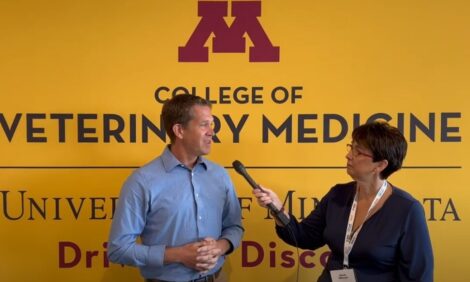



AASV: Tongue tip fluid sampling for PRRS
Stillborn tongue tip exudate is a viable postmortem specimen for PRRS monitoring[Excerpts from papers presented during the 2024 conference of the American Association of Swine Veterinarians]
Processing fluid has emerged as a sensitive tool for porcine reproductive and respiratory syndrome virus (PRRSV) monitoring, suggesting the use of tissues as viable specimens. Tongue tip exudate has recently gained attention as a viable postmortem specimen for PRRS monitoring.
A study by Mariana Kikuti, DVM, PhD, and colleagues at the University of Minnesota, aimed to determine whether postmortem sampling of suckling pigs allows for the detection of PRRSV and determining the sensitivity of each postmortem specimen studied.
Two farrow-to-wean farms undergoing a wild-type PRRS virus that had decided to pursue elimination were conveniently selected. Samples were collected at the farm some 8 and 20 weeks after the outbreak detection. Postmortem sampling of piglets found dead or euthanized was conducted.
Postmortem specimens consisted of individual sterile swabs of the nasal, oral, and rectal cavities, tongue tips and blood collected directly from the heart. All specimens were stored and tested individually for PRRSV by rRT-PCR. Additionally, blood was collected via jugular venipuncture from 30 and 60 live piglets during the first and second sampling points, respectively. Sera from live piglets were tested for PRRSV by rRT-PCR.
PRRSV was detected by rRT-PCR in 79% of live piglets’ sera on farm 1 visit 1 (F1V1), 10% on farm 1 visit 2 (F1V2), 63% on farm 2 visit 1 (F2V1), and 0% of farm 2 visit 2 (F2V2). Overall, oral swab sensitivity when compared to the same dead animal’s serum was 90.9%, 84.8% for nasal swabs, 75.8% for rectal swabs and 97.0% for tongue tips. Compared to sera, agreement ranged from 70.2% for tongue (kappa 0.45, P<0.001) to 89.6% for oral and nasal swabs (kappa 0.77, P<0.001).
Any of the added specimen types were capable of identifying PRRSV on F1V1, F1V2 and F2V1. PRRSV was identified in F2V2 through serum and tongue tips, possibly due to environmental contamination. Although this may be an issue when trying to assess within-herd prevalence, having highly sensitive detection methods, even those that detect environmental contamination, might help in detecting the presence of the virus on a farm, concluded Kikuti and her colleagues.
Evaluation of PRRSV vertical transmission
PRRSV transmission to piglets may come directly from sows or littermates. Although approximately 85% of the breeding herd is in the gestation phase, there is no practical and reliable method for PRRSV surveillance validated for that group. While processing fluid is a practical, affordable, and sensitive approach for screening suckling pigs for PRRSV, it does not answer whether PRRSV came from sows, other pigs, or contaminated fomites.
Conversely, tongue tip fluids (TTF) is a risk-based sample as it targets dead pigs. It has been documented that stillborn pigs are more likely to test PRRSV-positive than live newborn littermates.
The objective of a study by Isadora Machado, DVM, MS, and colleagues at Iowa State University, was to evaluate PRRSV vertical transmission by using stillborn TTF to PRRSV RNA by RT-qPCR.
Two PRRSV-positive unstable herds were recruited for this study. Within 24 hours of farrowing, sow tonsil scraping, stillborn serum, and stillborn TTF within the litter were collected. A total of 66 sows and their stillborn piglets were tested within 24 hours post-farrow. Thirty-three litters (50%) had at least one PRRSV-positive result of tonsil scraping, stillborn TTF, or stillborn serum samples.
There were 19 sows (29%) PCR-positive on tonsil scraping, of which five litters had at least one stillborn TTF positive, and four had at least one stillborn serum positive. Overall, 19 litters (29%) had at least one TTF-positive, and 11 litters (17%) had at least one serum sample positive.
Except for one stillborn pig, all serum-positive stillborn piglets also tested positive for TTF, while 14 stillborn piglets were PRRSV-positive on TTF with negative results for serum samples, and 94 stillborn piglets were negative on both TTF and serum sample.
TTFs from stillborn piglets are a proxy of the gestation population PRRSV status. Stillborn TTFs had a greater positivity than matching stillborn sera, possibly picking up viral RNA from systematically infected stillborn who were no longer viremic.
While tonsil sampling can effectively detect PRRSV RNA in pigs infected for a long period, this study revealed several instances of sows having PCR-negative tonsil scraping giving birth to PRRSV-positive piglets. This demonstrates that relying solely on sow tonsil scraping for PRRSV detection may not reflect the offspring’s status. To optimize cost and time, collecting multiple tongue tips in the same bag can be employed, like the approach used for processing fluids.







